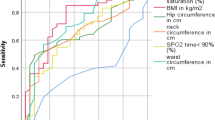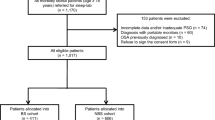Abstract
Purpose
Syndrome Z is the occurrence of metabolic syndrome (MS) with obstructive sleep apnea. Knowledge of its risk factors is useful to screen patients requiring further evaluation for syndrome Z.
Methods
Consecutive patients referred from sleep clinic undergoing polysomnography in the Sleep Laboratory of AIIMS Hospital, New Delhi were screened between June 2008 and May 2010, and 227 patients were recruited. Anthropometry, body composition analysis, blood pressure, fasting blood sugar, and lipid profile were measured. MS was defined using the National Cholesterol Education Program (adult treatment panel III) criteria, with Asian cutoff values for abdominal obesity.
Results
Prevalence of MS and syndrome Z was 74% and 65%, respectively. Age, percent body fat, excessive daytime sleepiness (EDS), and ΔSaO2 (defined as difference between baseline and minimum SaO2 during polysomnography) were independently associated with syndrome Z. Using a cutoff of 15% for level of desaturation, the stepped predictive score using these risk factors had sensitivity, specificity, positive predictive value, and negative predictive value of 75%, 73%, 84%, and 61%, respectively for the diagnosis of syndrome Z. It correctly characterized presence of syndrome Z 75% of the time and obviated need for detailed evaluation in 42% of the screened subjects.
Conclusions
A large proportion of patients presenting to sleep clinics have MS and syndrome Z. Age, percent body fat, EDS, and ΔSaO2 are independent risk factors for syndrome Z. A stepped predictive score using these parameters is cost-effective and useful in diagnosing syndrome Z in resource-limited settings


Similar content being viewed by others
References
Wilcox I, McNamara SG, Collins FL, Grunstein RR, Sullivan CE (1998) “Syndrome Z”: the interaction of sleep apnoea, vascular risk factors and heart disease. Thorax 53(Suppl):S25–S28
Shahar E, Whitney CW, Redline S, Lee ET, Newman AB, Javier Nieto F, O’Connor GT, Boland LL, Schwartz JE, Samet JM (2001) Sleep-disordered breathing and cardiovascular disease: cross-sectional results of the Sleep Heart Health Study. Am J Respir Crit Care Med 163:19–25
Peker Y, Hedner J, Norum J, Kraiczi H, Carlson J (2002) Increased incidence of cardiovascular disease in middle-aged men with obstructive sleep apnea. Am J Respir Crit Care Med 166:159–165
Reaven G (2002) Metabolic syndrome: pathophysiology and implications for management of cardiovascular disease. Circulation 106:286–288
Peppard PE, Young T, Palta M, Skaturd J (2000) Prospective study of the association between sleep-disordered breathing and hypertension. N Eng J Med 342:1378–1384
Wolk R, Shamsuzzaman AS, Somers VK (2003) Obesity, sleep apnea, and hypertension. Hypertension 42:1067–1074
Ip MS, Lam B, Ng MM, Lam WK, Tsang KW, Lam KS (2002) Obstructive sleep apnea is independently associated with insulin resistance. Am J Respir Crit Care Med 165:670–676
Punjabi N, Sorkin J, Katzel L, Goldberg AP, Schwartz AR, Smith PL (2002) Sleep-disordered breathing and insulin resistance in middle-aged and overweight men. Am J Respir Crit Care Med 165:677–682
Coughlin SR, Mawdsley L, Mugarza JA, Calverley PM, Wilding JP (2004) Obstructive sleep apnoea is independently associated with an increased prevalence of metabolic syndrome. Eur Heart J 25:709–711
Basta M, Vgontzas A (2007) Metabolic abnormalities in obesity and sleep apnea are in a continuum. Sleep Med 8:5–7
Sharma SK, Reddy EV, Sharma A, Kadhiravan T, Mishra HK, Sreenivas V, Mishra HK, Lakshmy R (2010) Prevalence and risk factors of syndrome Z in urban Indians. Sleep Med 11:562–568
Stoohs RA, Facchini F, Guilleminault C (1996) Insulin resistance and sleep-disordered breathing in healthy humans. Am J Respir Crit Care Med 154:170–174
Gruber A, Horwood F, Sithole J, Ali NJ, Idris I (2006) Obstructive sleep apnoea is independently associated with the metabolic syndrome but not insulin resistance state. Cardiovasc Diabetol 5:22
Sharma SK, Kumpawat S, Goel A, Banga A, Ramkrishnan L, Chaturvedi P (2007) Obesity and not obstructive sleep apnea is responsible for metabolic abnormalities in a cohort with sleep disordered breathing. Sleep Med 8:12–17
Venkateswaran S, Shankar P (2007) The prevalence of syndrome Z (the interaction of obstructive sleep apnoea with the metabolic syndrome) in a teaching hospital in Singapore. Postgrad Med J 83:329–331
Sharma SK, Kurian S, Malik V, Mohan A, Banga A, Pandey RM, Handa KK, Mukhopadhyay S (2004) A stepped approach for prediction of obstructive sleep apnea in overtly asymptomatic obese subjects: a hospital based study. Sleep Med 5:351–357
Rechtschaffen A, Kales AA (1968) A manual of standardized terminology, techniques and scoring for sleep stages of human subjects. Government Printing Office. NIH Publication No. 204, Washington, DC
Iber C, Ancoli-Israel S, Chesson A, Quan SF, for the American Academy of Sleep Medicine (2007) The AASM manual for the scoring of sleep and associated events: rules, terminology and technical specifications. American Academy of Sleep Medicine, Westchester
Sharma SK, Kumpawat S, Banga A, Goel A (2006) Prevalence and risk factors of obstructive sleep apnea syndrome in a population of Delhi, India. Chest 130:149–156
Davies RJO, Stradling JR (1990) The relationship between neck circumference, radiographic pharyngeal anatomy and obstructive sleep apnoea. Eur Respir J 3:509–514
Bairaktari E, Hatzidimou K, Tzallas C, Vini M, Katsaraki A, Tselepis A, Elisaf M, Tsolas O (2000) Estimation of LDL cholesterol based on the Friedewald formula and on apo B levels. Clin Biochem 33:549–555
Expert panel on detection, evaluation and treatment of high blood cholesterol in adults (2001) Executive summary of the third report of the National Cholesterol Education Program (NCEP) expert panel on detection, evaluation and treatment of high blood cholesterol in adults (adult treatment panel III). JAMA 285:2486–2497
Choo V (2002) WHO reassesses appropriate body-mass index for Asian populations. Lancet 360:235
WHO expert consultation (2004) Appropriate body-mass index for Asian populations and its implications for policy and intervention strategies. Lancet 363:157–163
Muraki I, Tanigawa T, Yamagishi K, Sakurai S, Ohira T, Imano H, Kiyama M, Kitamura A, Sato S, Shimamoto T, Konishi M, Iso H, Investigators CIRCS (2010) Nocturnal intermittent hypoxia and metabolic syndrome; the effect of being overweight: the CIRCS study. J Atheroscler Thromb 17:369–377
Iiyori N, Alonso LC, Li J, Sanders MH, Garcia-Ocana A, O’Doherty RM (2007) Intermittent hypoxia causes insulin resistance in lean mice independent of autonomic activity. Am J Respir Crit Care Med 175:851–857
Wetter DW, Young TB, Bidwell TR, Badr MS, Palta M (1994) Smoking as a risk factor for sleep disordered breathing. Arch Intern Med 154:2219–2224
Reddy EV, Kadhiravan T, Mishra HK, Sreenivas V, Handa KK, Sinha S, Sharma SK (2009) Prevalence and risk factors of obstructive sleep apnea among middle-aged urban Indians: a community-based study. Sleep Med 10:913–918
Lam JC, Lam B, Lam CL, Fong D, Wang JK, Tse HF, Lam KS, Ip MS (2006) Obstructive sleep apnea and the metabolic syndrome in community-based Chinese adults in Hong Kong. Respir Med 100:980–987
Acknowledgments
We thank sleep technicians Mr. Jitender Sharma, Mr. Jitender Kumar, and Mr. Amit Solomon for performing the polysomnographies and for their assistance in data collection. The authors also thank all the study subjects who voluntarily consented to participate in the study.
Conflict of interest statement
None of the authors have any conflict of interest.
Funding
Pfizer India, Ltd., the sponsors, had no role in the study design, data analysis, and in writing the manuscript.
Author information
Authors and Affiliations
Corresponding author
Rights and permissions
About this article
Cite this article
Agrawal, S., Sharma, S.K., Sreenivas, V. et al. Stepped approach for prediction of syndrome Z in patients attending sleep clinic: a north Indian hospital-based study. Sleep Breath 16, 621–627 (2012). https://doi.org/10.1007/s11325-011-0548-3
Received:
Revised:
Accepted:
Published:
Issue Date:
DOI: https://doi.org/10.1007/s11325-011-0548-3




